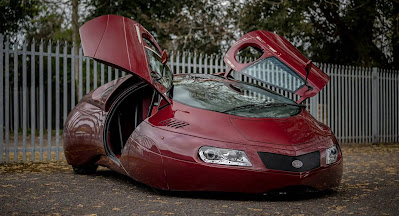Silent BEAST - It appears you're not quite thrilled when discussing the latest concept
cars. Well, let's shift our focus to some classic supercars like this
one. In the realm of automotive excellence, the Jaguar C-X75 stands as a testament to the artistry and innovation that has defined Jaguar for 75 glorious years. Born in 2010 to commemorate this milestone, the C-X75 is not just a feast for the eyes but also an environmentally friendly marvel. This hypercar is propelled by pure electric power, thanks to a battery ingeniously positioned beneath its sleek frame.
 |
| The Jaguar C-X75 stands as a testament to the artistry and innovation that has defined Jaguar for 75 glorious years. (Picture from: OtoDriver) |
Developed in collaboration between Jaguar Land Rover Special Vehicle Operations and William Advanced Engineering, this engineering masterpiece hails from the heart of Oxfordshire, England. A single glance at its exterior reveals an automotive symphony of beauty and performance. The C-X75 embodies the essence of a direct descendent of the XJ220, with a distinctive vent gracing its hood.
 |
| The Jaguar C-X75 is developed in collaboration between Jaguar Land Rover Special Vehicle Operations and William Advanced Engineering, this engineering masterpiece hails from the heart of Oxfordshire, England. (Picture from: RoadAndTrack) |
The front bumper exudes aggression, adorned with black air inlets on either side of its expansive grille. The slanting headlights gracefully adorn the hood's sides, a testament to Jaguar's capability in competing with Italian counterparts. Air vents beneath the doors, left and right, artfully direct wind from the front to the car's sides, ensuring impeccable downforce. As for the rear, it boasts LED taillights that stretch seamlessly from the fender to the stern, complemented by a menacing black diffuser on the rear bumper. It's nothing short of fabulous.
 |
| The Jaguar C-X75 featured with air vents beneath the doors, left and right, artfully direct wind from the front to the car's sides, ensuring impeccable downforce. (Picture from: MotorAuthority) |
Stepping into the interior, you'll find the dashboard and seats luxuriously swathed in Alcantara suede. The center console hosts a user-friendly touchscreen, a signature feature in Jaguar's line-up. The transmission lever emulates the elegance of a Ferrari, adorned with buttons for R (Reverse), N (Neutral), and D (Drive). To infuse a sporty vibe, Jaguar has incorporated a black carbon panel.
 |
| Stepping into the Jaguar C-X75's interior, you'll find the dashboard and seats luxuriously swathed in Alcantara suede. (Picture from: Uncrate) |
The true marvel of the Jaguar C-X75 lies beneath the surface. Four electric motors, one embedded in each wheel, collectively generate a staggering 195 horsepower per wheel. This symphony of power propels the electric marvel to a top speed of 329 kilometers per hour (204.43 miles per hour), with the ability to sprint from 0 to 100 kilometers per hour (62 miles per hour) in just 3.4 seconds.
 |
| The Jaguar C-X75 is powered by four electric motors, one embedded in each wheel, collectively generate a staggering 195 horsepower per wheel. (Picture from: Uncrate) |
The battery, meticulously tucked beneath the car, provides an impressive range of 110 kilometers (68 miles) on a single recharge. However, for those seeking more extensive adventures, there's the Range-Extended Electric Vehicle (RE-EV) version. This innovative configuration combines electric motors with micro gas-turbines, delivering an astounding range of 900 kilometers (559 miles).
 |
| The Jaguar C-X75 is is propelled by pure electric power, thanks to a battery ingeniously positioned beneath its sleek frame. (Picture from: SecretClassics) |
The C-X75 is an epitome of eco-friendliness, emitting a mere 99 grams of carbon dioxide per kilometer. Yet, despite its groundbreaking features and eco-conscious design, Jaguar delivered a disappointing blow to the automobile world. On December 17, 2012, they announced the cancellation of C-X75 production due to unfavorable global economic conditions.
In 2015, the C-X75 made a stunning appearance in the film "Spectre," a James Bond thriller that showcases the iconic British secret agent's daring exploits. While Bond typically favors Aston Martin DB10, the C-X75 managed to steal the spotlight. Its presence in this high-octane cinematic experience underlines its undeniable allure.
 |
| The Jaguar C-X75 made a stunning appearance in the film "Spectre," a James Bond thriller that showcases the iconic British secret agent's daring exploits back in 2015. (Picture from: OtoDriver) |
This isn't the first time Jaguar has graced the silver screen with James Bond. In the 2006 film "Casino Royale," the XJ8, XJR, and XKR made their thrilling appearances, followed by the XKR in the 2002 film "Die Another Day." Jaguar's collaboration with the world of espionage adds a touch of sophistication and class to these adrenaline-pumping adventures.
 In conclusion, the Jaguar C-X75 is a breathtaking fusion of art, innovation, and eco-conscious engineering. Its elegant design and eco-friendly power make it a standout in the automotive world. While its production may have been short-lived, its legacy lives on in the annals of iconic automobiles, adding a touch of class to the high-octane world of James Bond. *** [EKA | FROM VARIOUS SOURCES | ROADANDTRACK | WIKIPEDIA | AUTOCAR | SECRETCLASSICS | ROBBREPORT | MOTORAUTHORITY | UNCRATE ]
In conclusion, the Jaguar C-X75 is a breathtaking fusion of art, innovation, and eco-conscious engineering. Its elegant design and eco-friendly power make it a standout in the automotive world. While its production may have been short-lived, its legacy lives on in the annals of iconic automobiles, adding a touch of class to the high-octane world of James Bond. *** [EKA | FROM VARIOUS SOURCES | ROADANDTRACK | WIKIPEDIA | AUTOCAR | SECRETCLASSICS | ROBBREPORT | MOTORAUTHORITY | UNCRATE ]Note: This blog can be accessed via your smart phone.







































